
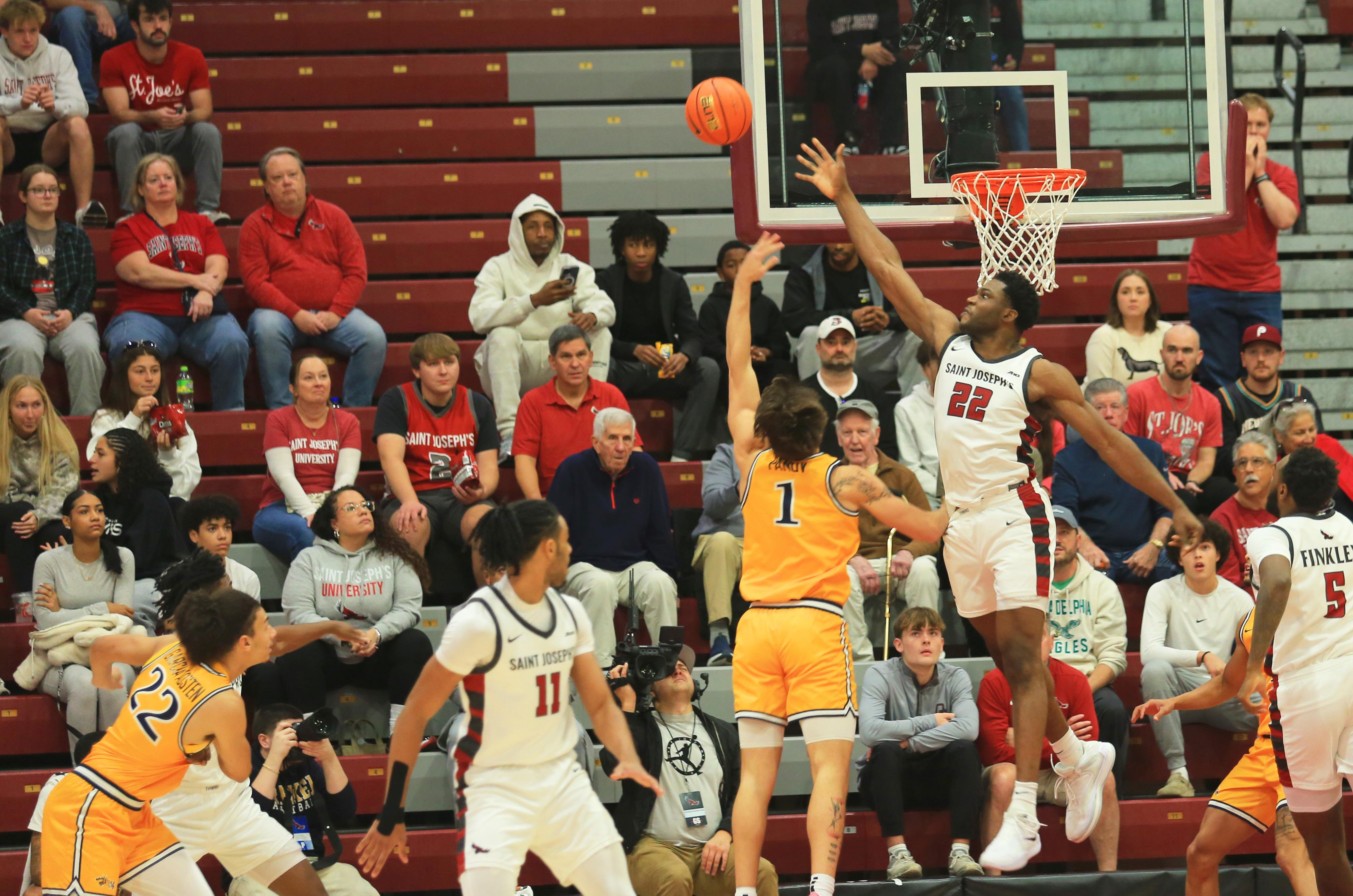



‘We don’t want anyone in our community to go hungry’
inclusive excellence faculty liaison.
“There’s a lot of concern on the part of students who either rely on SNAP themselves or who live with, or perhaps support, family members who rely on SNAP,” Lee said.
Campus organizations tasked with addressing students’ basic needs are working to meet the increased demand caused by recent reductions and pauses in the Supplemental Nutrition Assistance Program.
The federal government suspended funding for SNAP Nov. 1 due to the government shutdown.
SNAP, which provides money to low-income Americans to purchase food, supports 42 million Americans. Roughly 472,000 Philadelphia residents, or 30% of Philadelphia’s population, rely on SNAP.
Since the shutdown began, SNAP has been the subject of many legal battles over whether the federal government should continue to provide benefits or how much should be provided.
U.S. District Judge John McConnell ordered the Trump administration to make full payments to SNAP recipients Nov. 6. Pennsylvania Governor Josh Shaprio’s office announced Nov. 7 that the Shapiro administration would immediately issue full SNAP benefits to Pennsylvania residents who had not received their SNAP payment.
The Supreme Court then issued a pause to judge McConnell’s order in the late evening of Nov. 7.
Hundreds of students or their family members across all three campuses receive SNAP benefits, according to Elizabeth Lee, Ph.D., associate professor of sociology and
Becki Scola, Ph.D., associate provost of inclusive excellence and institutional effectiveness, and Ross Radish, J.D., vice president of student life and dean of students, issued an announcement to students and faculty Nov. 7. In the announcement, Scola and Radish highlighted on-and off-campus resources for members of the St. Joe’s community to utilize, as well as resources where community members can donate.
“We are working to organize other resources to mitigate this challenge and support members of our University community who are experiencing food insecurity,” the announcement said.
Sage Olnick, academic success coach in the School of Nursing and Allied Health on the Lancaster campus, said she has heard concerns from students.
“A lot of our students are parents, or they are caring for parents,” Olnick said. “They’re often working, but because of their commitment to their academics, they may have stepped back in hours, and so because of that, we have absolutely heard from students who rely on SNAP benefits and other forms of assistance to help them make ends meet.”
Use of on-campus resources like HawkHUB has increased this semester, especially just before and after the pause in benefits, said Jenny Spinner, Ph.D., professor of English and faculty director of
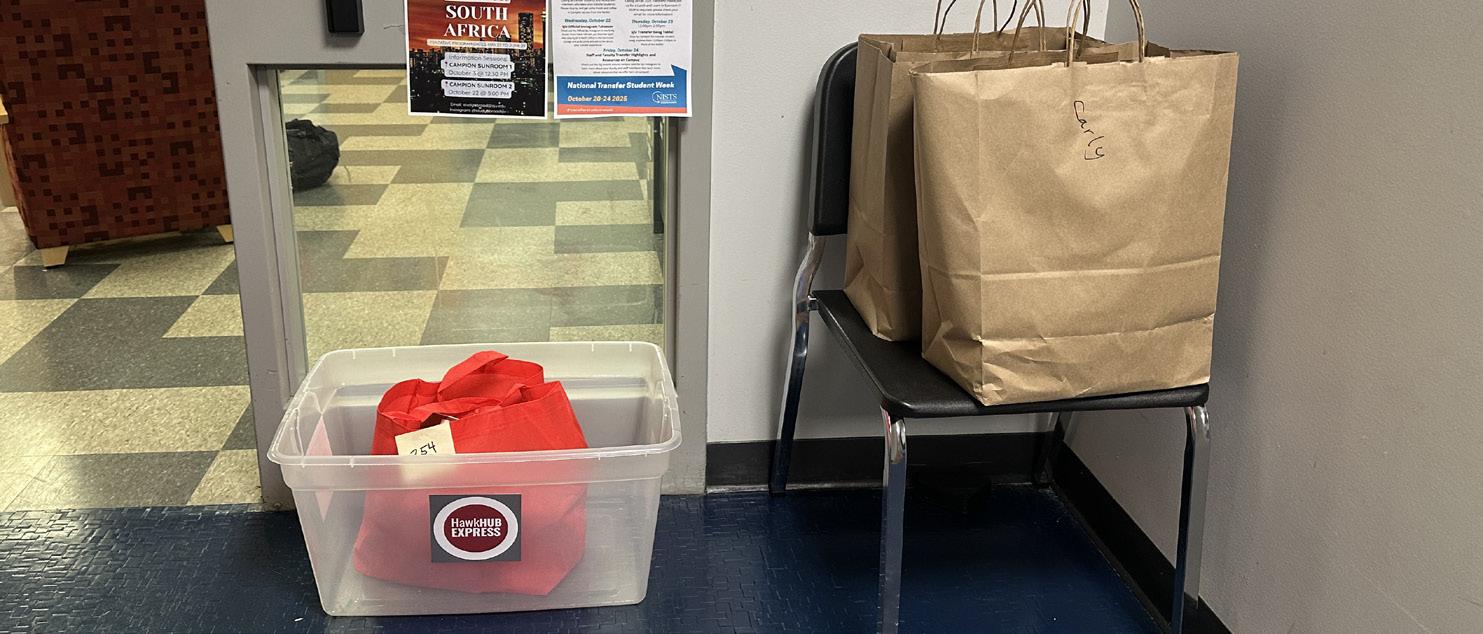
HawkHUB, the university’s food and basic needs resource center.
HawkHUB experienced a 50% increase in walk-in users across all of its locations from Oct. 20 to Nov. 9, according to data compiled by Joseph Pepe ’27, a member of HawkHUB’s data and evaluation team.
Spinner said the increase does not include online HawkHUB orders, and added that usage of community sites where HawkHUB volunteers has also increased.
“A lot of the discussion about food insecurity on college campuses is about how invisible it is,” Spinner said. “It’s definitely more visible right now, not just at St. Joe’s but in the community at large.”
Stephanie Hentz, clinical instructor and director of HawkHUB on the Lancaster campus, said she has noticed this increase in HawkHUB’s usage on the Lancaster campus. Hentz wrote in an email to The Hawk that students primarily utilize the online order option, and the items requested are “more meal-type items,” like pasta, sauce, soups, rice, oatmeal and tuna,
as well as hygiene products.
Lee said the university is also concerned with students experiencing stress and anxiety because they are worried about securing their next meals.
“We’re very sensitive to the fact that when there is food insecurity, it also has other kinds of implications than just the insecurity itself,” Lee said.
The Student in Need Fund, which is also a listed resource in the Nov. 7 email, is part of the Student Success Center. The fund allows students to receive meal swipes, loaner computers and emergency expenses.
Kim Allen-Stuck, Ph.D., assistant vice president of student success and educational support, said as of Nov. 10, there have been seven requests made via the Students in Need fund since the university email was sent. Allen-Stuck called this number “an uptick for this time of year.” At the end of the spring 2025 semester, 197 meal swipes were donated, and there are currently 136 remaining, according to Allen-Stuck.
‘We’re feeling a lot of pressure’
Spinner said HawkHUB is funded solely through donations and grants.
“We’re feeling a lot of pressure, the pressure that comes from wanting to serve to meet this moment of need,” Spinner said. “I spend a lot of my waking hours worrying about our capacity to do this, but we’re giving it everything we have. We don’t want anyone in our community to go hungry.”
In addition to continuing its on-campus efforts, HawkHUB is also working to make sure people across St. Joe’s are aware of other
resources that can help, said Oscar Nama ’27, co-president of HawkHUB.
“We’ve also been doing more social media outreach … trying to get more eyes on other resources around so that people at University City or Lancaster or around here know that there are other resources besides HawkHUB,” Nama said.
Olnick said the St. Joe’s community needs to come together to help those impacted.
“[We need to creatively think] through how we as an institution, how we as one university, can work together so that food insecurity and basic needs do not become
a barrier to our students’ success and progression throughout their academic programs so that they can reach their goals and serve our community,” Olnick said.
One way community members can get involved, according to Hentz, is through donations.
“Members of the St. Joe’s community can help by considering [donating] canned goods, nonperishable items and hygiene products to the HawkHUB,” Hentz said.
Olnick said students’ ability to meet their needs is as important as their academic success, and the university’s response to this
moment is rooted in the Jesuit mission.
“When we think about what cura personalis means and caring for the whole person, I think part of that requires us to attend to students’ ability to access basic needs and resources that they need, not only to just live a healthy life but also to grow and have a positive impact on the world,” Olnick said. “To me, the biggest concern is their health, their well being and their ability to continue to reach the goal that brought them here in the first place.”

‘When we reduce stigma, we can increase access to care’
When Megan Armbruster ’24, M.S. ’26, entered her senior year of high school, she began noticing changes in her mother’s behavior.
“She was nodding off at the table, had suspicious friends over,” Armbruster recalled.
It wasn’t until Armbruster moved out of her mother’s house and into her father’s that she learned the extent of what her mother was going through. Her father told her that her mother had been struggling with addiction since Armbruster was a child.
“That opened my eyes to, ‘OK, this wasn’t out of nowhere,” Armbruster said. “She wasn’t abusing and using drugs when I was just in high school or just in that era of my life. It was a lifetime thing that she’s been doing.’”
Armbruster is not alone. Roughly 44% of Philadelphians know someone with substance use disorder, and one in three Philadelphians know someone who has died from an overdose, according to The Pew Charitable Trusts’ 2025 Philadelphia Resident Survey.
Experience doesn’t necessarily translate into understanding, however, and that misunderstanding often shows up in the language used to talk about substance use disorder and those affected by it. Words like “addict” and “abuser” remain widespread, carrying connotations that can reinforce stigma rather than empathy.
“People who struggle with drugs and alcohol, they’re already outcasts in so many ways, and it’s easy to further ostracize this population,” said Christopher Kelly, Ph.D., professor of sociology. “One way we do that is through the language [we use].”
Armbruster said she’s noticed how easy it is to fall into this pattern herself. While she catches herself using this kind of terminology when talking about her mother, she’s trying to stray away from it.
Context and intent matters, too, Armbruster said.
“It’s never comfortable talking with or about someone who is actively struggling with addiction,” Armbruster said. “I can say to a team of care people about my mother, ‘FYI, she’s an addict,’ but I think, on the vice versa, when somebody turns around to me and says, ‘Your mother’s an addict,’ that sits differently with me.” A 2023 study published in
Alcohol Dependence journal examining news articles, blogs, X posts and Reddit posts from the United States and other English-speaking countries found while stigmatizing language about addiction decreased by 68.2% in news articles and 33.6% in blogs from 2017 to 2021, it increased by 43.5% on X (formerly Twitter) and remained stable on Reddit. Terms including “addict,” “drug abuser” and “substance abuser” were most commonly found.
Nick Escurra, 23, of Delaware County, has struggled with addiction since he was prescribed Adderall at 12 years old. His experiences with Adderall “messed up” his emotional development and caused him to isolate himself from others, he said.
Escurra said there are consequences to the way people talk about substance use disorder.
“It causes more harm than good,” Escurra said. “It destroys someone’s mindset by being called rude and inconsiderate names.”
This stigmatizing language, according to Kelly, doesn’t just shape how society views people with substance use disorder. It can also have an internalization effect on those individuals, influencing how they see themselves.
“When we label somebody as an ‘addict’ or a ‘junkie’ or a ‘crackhead,’ it just further entrenches their secondary status in society,” Kelly said. “But it also gives them something that they can bond with other people who have been similarly labeled, and it reinforces an identity that I think most people, including themselves, would say is not the most healthy or productive.”
The National Institute on Drug Abuse advises people to ask those with substance use disorder how they want to refer to themselves. While some may choose to refer to themselves with those terms as a form of personal identification or reclamation, others should not impose those labels on them.
Jonathan Stoltman, Ph.D., co-founder and co-director of Reporting on Addiction, is at the forefront of a mission to shift how substance use disorder is discussed. Stoltman, who has been doing addiction-related research for over a decade, saw that current reporting often resulted in stigma and discrimination faced by people who use drugs.
In an effort to improve how substance use disorder is reported in the media, Stoltman and Ashton Marra, associate
professor of journalism at West Virginia University, co-founded Reporting on Addiction in 2020.
Reporting on Addiction is a collaboration between journalists, educators and addiction experts who work to improve media coverage of substance use disorder by reducing stigma, promoting evidence-based reporting and highlighting hope, treatment and recovery. It provides training, resources and guidance to ensure reporting reflects current science and treats people affected by substance use disorder with empathy and accuracy.
“If we can tell more stories that are empathetic, that help the audience actually understand that these are people that need help, they need support, they need services and we are failing them by not providing those things then we think that can help, ideally, reduce some of that dehumanization going forward,” Stoltman said.
In the end, it’s not just about words. Feeling judged or dehumanized often discourages people with substance use disorder from seeking treatment, according to the National Institute on Drug Abuse. Additionally, stigma can shape how healthcare providers perceive and respond to those with substance use disorder, sometimes resulting in lower-quality and discriminatory care.
“When we reduce stigma, we can increase access to care,” Stoltman said.
“But we can also increase community understanding of this issue so that they can think more broadly about those different solutions.”
This is the second story in a series by Cara Santilli ’24, M.A. ’26, about social issues affecting the Philadelphia community, how the media reports on those issues and what the community can do to help.
Editor’s Note: Associated Press Style standard practice is to use the term “addiction” when referring to a treatable disease that affects a person’s brain and behavior. This story uses terminology preferred by medical and health professionals to reduce stigma and accurately reflect the medical understanding of substance use disorder.
Members of the St. Joe’s community seeking support are encouraged to contact the following resources: Counseling and Psychological Services (CAPS), 610-660-1090
Campus Ministry, 610-660-1030
The Office of Student Outreach & Support, 610-660-1149
The Jesuit community, 610-660-1400 Employee Assistance Program, 866799-2728

BRYAN
BALMORES-JUMARANG ’27
Features Reporter
The Rev. Dan Ruff, S.J., Ph.D., bids farewell to St. Joe’s after 13 years of ministry, leaving behind a legacy of service and commitment to spirituality. Ruff worked in Campus Ministry at St. Joe’s from 1987 to 1990. He later returned in 2015 after spending eight years at Old St. Joseph’s Church in the Old City neighborhood of Philadelphia.
Ruff said he found his purpose within campus ministry while he was in a doctoral program at Duke University.
“All the life I was finding was with campus ministry, my peers,” Ruff said. “It was the first time I dealt with Catholics my age who were serious believers, and that made an impression on me.”
A focus of Ruff’s ministry at St. Joe’s was promoting men’s spirituality, which he designed two short retreats around. At these retreats, students would give talks on different topics. Following the talks, participants would journal, engage in personal prayer and then join together in small groups. At the end of the retreats, individuals would share their thoughts with the larger group.
Throughout his time at St. Joe’s, Ruff collaborated with Tom Sheibley, director of Campus Ministry. What struck Sheibley about Ruff was his willingness to help.
“He was a great pastoral presence, somebody who was always willing to reach out to students in need, to listen to students who needed someone to talk to,” Sheibley said. “He would step into taking on some of the positions in Campus Ministry that just needed to be handled.
Ruff also regularly contributed to University Singers, a diverse group of students, alums and faculty who perform choral music. He left an impact on River Hoffman ’26, a member of University Singers. Hoffman, who described Ruff as a “a dry humor kind of guy,” said Ruff inspired him to join the organization and commit to it.
“He would help me with the music and pronunciations, and he brought everybody in that environment together, just by his presence,” Hoffman said. “You know when he walked in the room.”
Jessica Kokotajlo ’26, head sacristan for Campus Ministry, is another one of Ruff’s mentees. Kokotajlo and Ruff helped out with Wednesday Worship, an hour-long
JUSTIN FRANCIS ’27
Special to The Hawk
DeAnna Capaldi ’27, a biomedical sciences major and neuroscience minor from South Philadelphia, is a passionate advocate for first-generation students on campus. Capaldi serves as president of St. Joe’s chapter of Tri-Alpha, the national first-generation honor society, which has around 100 members. She also works in the registrar’s office, serves as a Hawk Host, is a medical assistant at a local lab and is currently helping start the new first-gen club at St. Joe’s.
Capaldi’s leadership is rooted in her own experiences navigating college as a first-generation student and a desire to make things easier for those who come after her. She hopes to attend a physician assistant school after she graduates.
Why did you want to become president of Tri-Alpha?
I was looking to bring more first-gen activities to campus. I felt like there were some things, especially with our recent designation as a FirstGen Forward school…that we could do better … I saw a need for more advocacy and interaction, and I felt that that was the best way for me to have a platform to do that.
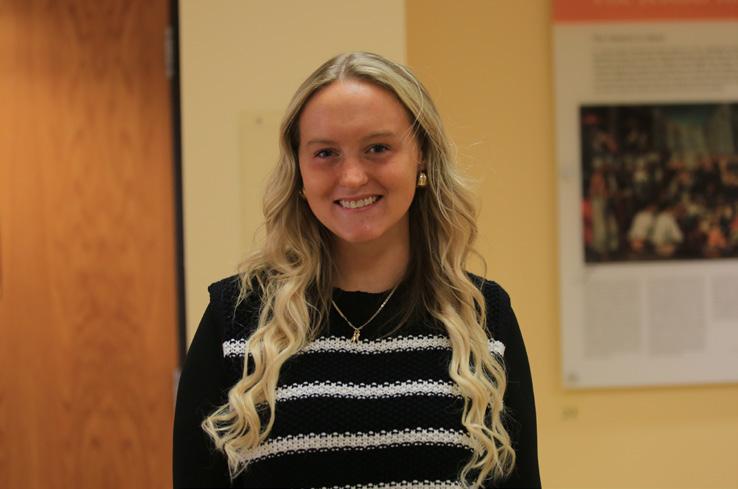
What is your goal for the new club you started for first-gen students?
My goal is to grow this club and use it to foster a more inclusive space on campus for first-generation college students. I hope to collaborate with organizations on campus that are important resources for these students to help them make the most of their experience here at SJU.
What is something about you that might surprise other people?
I try to show high confidence and go into every situation with my head high, even if I am not fully confident … but I think that it would surprise people that I do struggle a lot with imposter syndrome.
The full version of this Q&A is available to read online at sjuhawknews.com.
gathering in the Chapel of St. Joseph with eucharistic adoration, acoustic worship music, reconciliation and silent reflection.
“If I didn’t take that leap in my freshman year to go ask [Ruff] about Wednesday Worship and to help out with it, I don’t think I would be where I am right now as the head sacristan,” Kokotajlo said.
Outside of Wednesday Worship, Kokotajlo and Ruff also bonded over their shared love of theater and theatrical performances.
“There was a lot of times where it was a short conversation … talking about recent performances that he went to go see, whether it’s in Philadelphia or he found time to go up to New York City to go find a couple of other shows,” Kokotajlo said.
Some of Hoffman’s favorite memories with Ruff are on the days of University Singers concerts as they prepared to sing in front of the crowd.
“He was always just so ready to go,” Hoffman said. “He would be ready to talk to any student and be like, ‘You ready? Yeah, we got this.’”
Ruff said he’s “thoroughly enjoyed” his time at St. Joe’s and has watched Campus Ministry grow over the years.

“I think we, arguably, are doing a more creative and a more productive Campus Ministry program than we did when I first came here as a young priest … it’s been a great place to be,” Ruff said. “I’m proud of what we do here. I think our students are great … and you guys will all be in my prayers.”
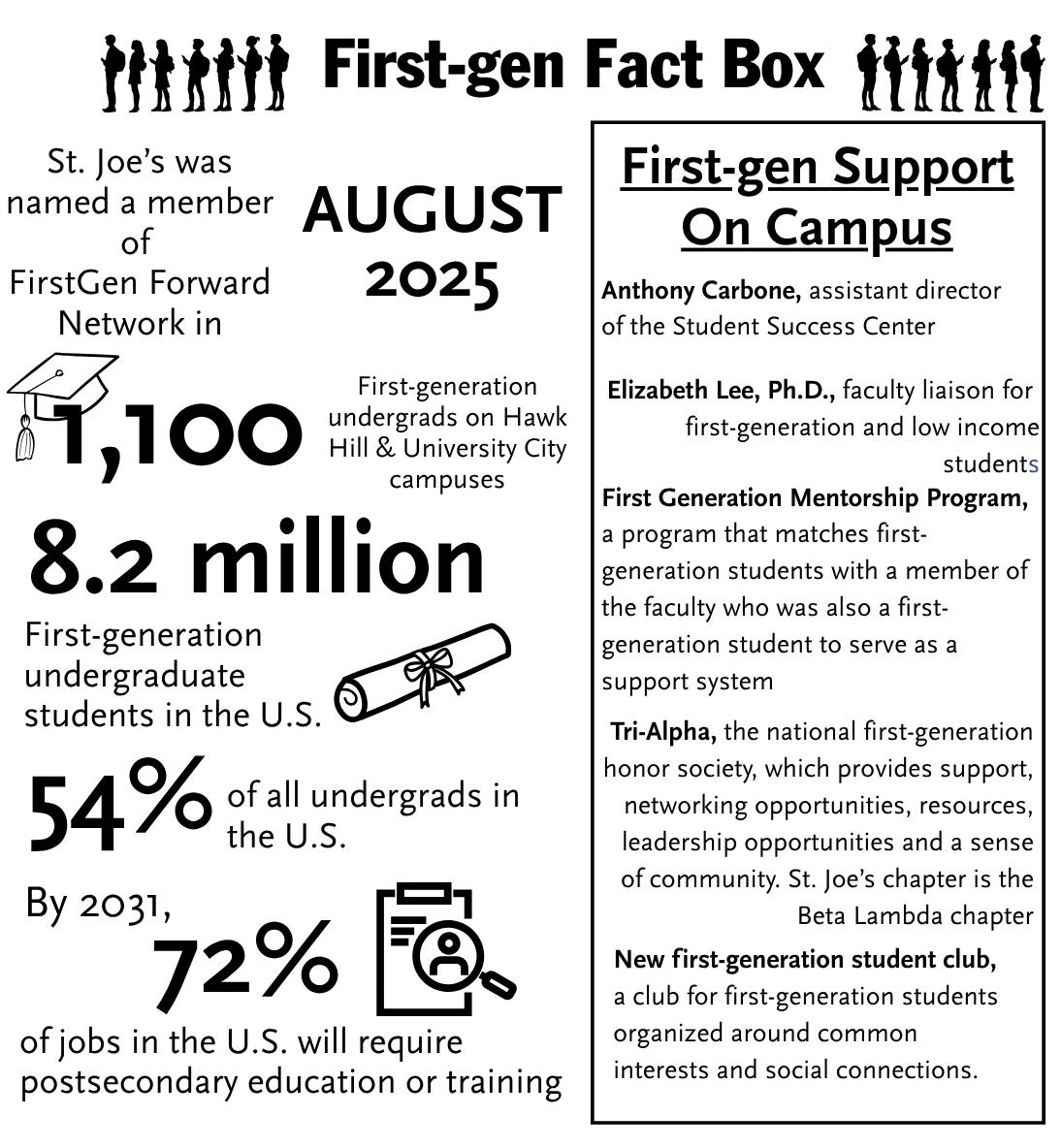
SOPHIA GALANTE ’26
News Reporter
St. Joe’s announced in mid-October that Manresa Hall, a nursing facility and home for retired Jesuit priests on the Hawk Hill campus, will be closing in the coming months. Kevin Gfeller ’20, associate director of public relations, provided the following information on behalf of Mike Gabriele, director of communications for the USA East Province Society of Jesus.
What is Manresa Hall?
Manresa Hall currently provides “skilled nursing care” for a community of 11 retired Jesuit priests and brothers. The facility, part of the Loyola Center on the
Hawk Hill campus, is operated by the Jesuits of the USA East Province.
Why is Manresa Hall closing?
Over the next 15 years, the number of Jesuits in the Province’s healthcare communities is expected to decline significantly. The USA East Province is, therefore, consolidating its four communities in line with what other provinces have done.
Was St. Joe’s involved in the decision to close Manresa Hall? No. The decision to close the facility was made by the Jesuits of the USA East Province. The Province has kept the university informed about the closure and the transition logistics.
When are the moves happening, and where will the Jesuits be moved to?
Over the next few months, most of the Jesuits in the facility are expected to move to the Colombiere Jesuit Community in Baltimore. Others will be relocated to Murray-Weigel Hall in New York City or the Campion Center in Weston/Boston, based on individual medical needs and bed availability.
What will happen to the building once the transition is complete?

The Province’s priority is safe, “person-centered transitions for resident Jesuits.” Decisions on the future use of Manresa Hall will be based on “mission, stewardship and consultation with partners in mission,” including St. Joe’s.

This past week, St. Joe’s participated in the National First-Generation College Celebration Day, annually recognized Nov. 8 to commemorate Lyndon B. Johnson’s passage of the Higher Education Act of 1965, and hosted its 2025 First-Generation College Celebration Week Nov. 3-7. As a Jesuit institution rooted in Ignatian values and led by University President Cheryl McConnell, Ph.D., who describes herself a “proud first-generation college graduate,” this celebration reflects the principles the university should continue to uphold.
Nov. 8 also marked the 60th anniversary of the act, which expanded the federal government’s role in higher education, including increased federal funding, scholarships and low-interest student loans. This also entailed expanding resources and creating opportunities for those from low-income and first-generation backgrounds.
In August, St. Joe’s was named a member
of the FirstGen Forward Network, recognizing the university’s efforts in supporting first-generation students. FirstGen Forward is a nonprofit of nearly 500 institutions that work together toward a mission of creating opportunities for first-generation students through “monthly workshops, networking and professional development opportunities.”
Currently, there are over 1,000 first-generation students across the Hawk Hill and University City campuses, which represent a significant portion of St. Joe’s student body. “Cura personalis,” or “care for the whole person,” at its best embodies this principle when it’s universally applied to everyone in our community, especially those who face excess barriers.
According to the university website, St. Joe’s is “committed to educating and caring for the whole person across all aspects of identity.” As a diverse community, it is imperative to continue fostering inclusive spaces for students of all
backgrounds to feel welcomed and self-assured in their identities and academic journeys. The university being represented by a first-generation graduate as its president is indicative of a greater message: First-generation students will accomplish great feats when given a community of support, necessary resources and encouraging mentorship. Celebrating National First-Generation College Celebration Day and associating with FirstGen Forward Network encourages wider recognition and understanding for the first-generation student college experience, as well as the potential these students hold.
The Hawk welcomes Letters to the Editor, typically no more than 250 words. They can be emailed to hawk.editorial@gmail.com.

JARED NACHIMSON ’27 Hawk Columnist

By all means, the most recent election cycle wasn’t supposed to be the most exciting. Yes, the cycle included important gubernatorial races in two recently competitive states — Virginia and New Jersey — and a highly contentious and highlighted mayoral race in New York City. However, the election cycle immediately after a major presidential contest often serves as a sleepy, off-year referendum on the current political makeup. With a presidential administration as divisive as Donald Trump’s and a polarizing political climate, many have viewed the recent election’s surprising success for the Democratic Party as part of a larger repudiation of the sitting Republican government. This, in turn, has generated hopes for future Democratic performances in Pennsylvania. Though the party is still recovering from the state’s rightward shift in the 2024 election cycle, the undeniable Democratic victories secured throughout
the state have possibly signaled voters’ realignment with Democratic candidates just one year before midterm elections.
Notable electoral victories this year for Pennsylvania Democrats include the three simultaneous Supreme Court retention races. Usually overlooked, these contests saw history-making spending by party-associated think tanks and organizations seeking to influence whether liberal justices Christine Donohue, Kevin Dougherty and David Wecht would retain their seats. This demonstrates the importance of this election for Democrats, especially concerning rulings on topics like abortion, voting rights and equal representation. However, despite the huge amounts of campaign money spent and relatively immense campaigning, the justices’ dutiful re-elections are likely due to the rarity of justices being rejected.
Additionally, Democratic victories for attorney general and county sheriff in the politically purple, recently Trump-voting Bucks County ostensibly signaled a desire for accountability from the current Republican attorney general and a reassessment of the
police’s tacit cooperation with Immigration and Customs Enforcement. What the results entail for the Democratic Party remains to be determined. The outcomes indicate, to some extent, disapproval of Republicans’ current management of the country and suggest potential Democratic gains in next year’s high-stakes midterms. Regardless, nothing is set in stone, and Democrats should continue to reassess their principles as new up-and-coming politicians embrace and fight for more progressive ideas.

CAROLINE TRIMBLE ’26
Assistant Opinions Editor

The blue wave swept across the nation on election day, with Democrats winning key races in New Jersey, New York and Virginia. Although each victory has been celebrated by Democratic voters, none have seen nearly as much coverage as Zohran Mamdani’s mayoral campaign in New York City. But what exactly sets Mamdani apart from his Democratic counterparts?
Mamdani, born in Uganda and raised in New York City, made history with his win Nov. 4; he is both the first Muslim and democratic socialist mayor of New York City. He ran a campaign far different from establishment Democrats, relying on grassroots volunteers and donations from everyday people to further his agenda. His success against the highly experienced — though morally
reprehensible — Andrew Cuomo suggests a shift in the Democratic Party toward a democratic socialist ideology, offering the possibility of change in the lives of more vulnerable individuals and the middle-class alike.
Mamdani’s success can be attributed to his policy platform. Some of his campaign promises include freezing the rent in the city, free busing, no-cost childcare and city-owned grocery stores, all of which he plans to pay for by raising income taxes by 2% on New Yorkers making $1 million per year and matching New Jersey’s state corporate tax rate of 11.5%. These changes — which will only affect individuals who can afford increased tax rates — are projected to generate about $9 billion dollars in revenue, which, in conjunction with $1 billion raised through “smart governance” policies, will be utilized to make the city more affordable.
Mamdani’s campaign reflects the true purpose of an elected official: to acknowledge the dignity of the human
person and better the lives of those they represent. Affordable housing, groceries and childcare should not be luxuries that only the wealthy can afford. Mamdani does not have to be a one-of-a-kind candidate whose platform only benefits
can successfully campaign on real issues affecting the working class without pandering to the establishment. The future looks bright for New York City under mayor-elect Mamdani.

MATT TSUCALAS ’29 Guest Columnist

New York City just elected a democratic socialist as their mayor, and the celebrations haven’t stopped — even though they maybe should. In a well-anticipated and overwhelming win, Zohran Mamdani has been chosen as the city’s next mayor. No matter where you stand on the political spectrum, Mamdani ran an undeniably strong and successful campaign, pulling at the heartstrings (or rather, pocketstrings) of desperate New Yorkers, offering highly idealistic promises to his voters.
While many call the election of this young democratic socialist the results of a successful electoral test — pushing the boundaries of what’s possible in U.S. elections — the real test begins Jan. 1 when the new mayor is sworn into office. While Democrats are busy celebrating
the triumph of their liberal prodigy, they should really be concerned about what’s at stake for both New York City and the Democratic Party.
Over the past few months, there have been numerous reports from both sides of the political spectrum that Mamdani’s policies are simply too idealistic and not financially sustainable, such as his city-run grocery stores, rent freezes and high corporate taxes — which, when put into action, will more than likely harm the average New Yorker’s cost and quality of living. Not only does this cause an issue for the city, but it will likely hurt Democrats in the coming years. With them putting a so-called “revolutionary” candidate into office, the expectations have now been raised, and when Mamdani’s policies don’t play out how he has promised they would (as is anticipated), Democrats will, once again, lose trust from their supporters, likely causing voters to move back toward the status-quo stances of Republicans for
a while.
No matter where you stand with his policies, with Mamdani now bound for the mayor’s office, what we all should do is hope for the best for New York. As for
the Democrats, though, I’d additionally suggest lowering your party hats and your expectations and begin hoping this new mayor’s policies work — for the sake of your voters, your city and your party.

MCKENNA GRAHAM ’27
Guest Columnist

Last week, singer Billie Eilish made headlines for her politics. At a recent award ceremony, she publicly criticized the wealth accumulation of billionaires, saying “if you are a billionaire, why are you a billionaire … give your money away,” while announcing a donation of $11.5 million from her current tour revenue to charity. The move was celebrated as bold and generous — but how much of it was genuine?
Eilish has been branding herself for years as a politically engaged, socially conscious activist. Yet the details of this latest stunt revealed a lack of transparency.
Despite denouncing the personal wealth of billionaires, Eilish’s multi-million dollar donation didn’t come directly from her personal wealth. Rather, it was crowdfunded by her fans. Her tour, predicted to gross $300 million, offered premium “changemaker tickets” — a more expensive option whose proceeds funded the charity donation. This was conveniently left out of her speech, and it remains undisclosed how much of the donation, if any at all, was actually from herself. This was philanthropy as a branding technique: Eilish makes headlines, maintains the moral credit and receives tax benefits, while her fans foot the bill.
The same week, Eilish asked her millions of Instagram followers to “vote
yes” on California Proposition 50, a redistricting measure designed to give Democrats more congressional seats. Due to federal regulatory gaps, celebrities are not required to disclose when they are being paid to endorse policies or candidates on social media. As a result, it is impossible to know if Eilish’s online endorsements were authentic or just another performance, but her recent lack of transparency invites speculation.
Maybe Eilish’s intentions were genuine, but nonetheless, these incidents parallel the greater trend in Hollywood today: politics functioning as branding. Celebrities use real issues to fabricate a moral authority because it sells. They can afford to push agendas that never impact their own lives, and, as long as
consumers keep buying into that illusion, performative activism will remain a profitable product.

cognitive analysis.
SAHR KARIMU ’26


Psychological studies on bilingualism and sensory perception show evidence that multilingualism affects our brain’s perception of the world. Psycholinguist Viorica Marian, Ph.D., notes bilingualism can alter both top-down and bottom-up processes of the brain. Psychologists define top-down processing as that which starts from the brain’s existing knowledge and then guides sensory interpretation, while they describe bottom-up processing as that which starts from sensory stimuli and then is used to inform higher
Marian notes “bilingual experience can lead to greater brain matter density and volume in regions associated with sensory processing.” In the experience of learning other languages, I believe we open ourselves to new realms of culture, each with their own corridors of history, art and philosophical traditions. These things — seeing culture, history and meaning differently through language — are the crux of a linguistic theory experts in the field posit as linguistic relativity.
The linguistic relativity theory asserts our native languages affect how we see the world. For example, in English, the number “92” is organized as one whole
numerical entity, whereas in French, it is thought of as “four 20s and 12,” or quatre-vingt douze. Another example to illustrate this concept is the way different languages describe color. In English, we say “dark blue” and “light blue,” with various gradients corresponding to our experience of the light, whereas in Russian, there are two distinct categories for blue: siniy (dark blue) and goluboy (light blue). These small shifts in a language’s code leave us with different ways of seeing color but also, ultimately, the world itself. Let us put on, with cheer, the new glasses of multilingualism so we may see the world more beautifully and through more lenses.


Every year, just like a bad habit, we complain about daylight saving time. Phones automatically adjust, clocks need to be set back an hour, coffee pots brew an hour earlier than necessary and social media explodes with people groaning about losing (or gaining) an hour of sleep.
While this timely ritual is expected, the collective annoyance still manages to surprise us twice a year. The only thing predictable is our attitude and bitterness to the day every March and November.
Daylight saving time has outlived and outstayed its welcome. In our screen-obsessed, blue light world, the supposed benefit of an hour more of daylight in the morning has lost its meaning. Daylight saving time was created
during World War I as a way to conserve power and fuel and work later in the day.
Daylight saving only confuses our circadian rhythms and makes pets who revolve around a set feeding time crankier. Yet, every March and November, politicians make noise about finally getting rid of it, as if this time they’ll actually do something about it. They don’t, and the day that even children have begun to groan about comes and passes.
The debate on getting rid of daylight saving time has gotten as pointless as the fall back or gain of one hour. The United States is one of a small number of countries worldwide — about 40% — that still observes daylight saving time. We know it’s unnecessary, and most people want it gone, but it’s always easier to complain than to coordinate change, isn’t it?
The day has become less about saving daylight and more about our collective
inaction to fix something everyone agrees is useless because we can’t come together to change it. So, we’ll just keep setting our clocks, grumble and pretend we’re
surprised every November and March, year after year, for a day that’s only still alive because of our misgivings.

CAROLINE KELLY ’26 Columnist

It seems like each month brings with it a new TikTok ideology, whether it be advice on how to live or some new trend. This past October, however, has seen the resurgence of what people call the “October Canon Event.”
The phrase “canon event” was popularized by the 2023 Sony film, “Spider-Man: Across the Spider-Verse.”
The idea is simple: every Spider-Man across every universe endures a transformative experience that essentially makes them Spider-Man. Furthermore, if a Spider-Man from a different universe attempts to avoid or interfere with this event, the consequences will be dire.
On TikTok, the application of this
phrase is a little different, as the event it’s being applied to doesn’t necessarily have to be life-altering or painful. But when it comes to October canon events, it seems most people are speaking of painful things, such as breakups, losing friends or just life not going their way.
I find the specific idea of bad things occurring in October interesting, as it’s a transitional month. Fall is arriving, and with it cold weather and less sunlight. For college students, school often ramps up, leaving many increasingly stressed. For those with seasonal depression, or who are simply not fans of winter, the approaching months seem daunting. So, perhaps the increased amount of unfortunate events is just a mirror of the change in season and conditions.
Lastly, TikTok, of course, has a penchant for blowing things out of proportion. Misery loves company, and
that company can be found on TikTok.
But, at the end of the day, if you’ve gone through an “October Canon Event,” you are not alone. And, hopefully, you can
take comfort in knowing spring will come, and whatever your event was, you’ll be OK. Promise.

TAYLA J. EVANS ’27
Features Editor
SOPHIA GALANTE ’26
News Reporter
As the blue-toned lights illuminated the tall wood and metal platform standing on the Bluett Theatre stage, the cast of SJU Theatre Company’s production of “Rent” crooned the musical’s titular song, desperation clinging to their voices.
Based on the 1896 opera “La bohème” by Giacomo Puccini, Luigi Illica and Giuseppe Giacosa and written and composed by Jonathan Larson, “Rent” follows the story of a group of friends and artists navigating poverty, houselessness and the AIDS crisis. “Rent” won both the Tony Award for Best Musical and the Pulitzer Prize in Drama in 1996.
Renee Dobson, M.F.A., associate professor of performing arts and director of the musical, said “Rent” was one of the first musicals that featured queer relationships in the principal cast. The principal characters are, Dobson said, not simply characters but reflections of people who were combatting the AIDS epidemic.
“I hope that [audiences] find some empathy for one or more of the characters,” Dobson said. “I think this show is really trying to communicate human empathy for some of the suffering that the characters are going through.”
Dobson said the cast and crew feel they are communicating an important message to audiences. Specifically, Dobson pushed for an ensemble curtain call, where the entire cast bows together, not just one by one.
“I think that says a lot about what it takes to do the show, which is a group of people that are absolutely entwined and committed to each other and they can trust each other out there creating it,” Dobson said.
Sara Stoud ’27 plays the role of Joanne Jefferson, an ivy-league educated lawyer with powerful parents and the girlfriend of performance artist Maureen Johnson. The community aspect of “Rent,” Stoud said, is crucial to relay on stage.
“I really hope that [the audience] takes away the community that we try and build, and the story that we try and tell — that Jonathan Larson tried to tell,” Stoud said. “I think it’s a really powerful message, that
there’s no day but today, that today could be the last day, that this could be the last hour, last minute and that you should cherish every moment with the people that you’re with.”
Ryan Garvey ’26, who plays Mark Cohen, an unsuccessful filmmaker who narrates the show, also stressed the importance of community. Garvey said his character functions as a storyteller who enables voices to be heard that otherwise would not be.
“I hope they take away that community is so important to everyone,” Garvey said.
“In any walk of life, you need people, and regardless of where you come from — your social, political, economic background — no one’s out here doing it alone. We all need each other.”
Sydney Wynn ’26, who plays Mimi Márquez, an exotic dancer who is HIV-positive and struggles with substance abuse disorder, said she hopes audiences step away from the show and approach others with kindness. Wynn said her role reflects the importance of living authentically and in the moment.
“I think the audience should remember to look at each other and remember that all of us are human, and no matter what

happens, no matter what we look like, no matter what we act like, no matter what hobbies we’re interested in, no matter what people we love, no matter what ethnicity we are, no matter what we believe in, what we don’t believe in, we’re all human, and we’re all just trying to live together,” Wynn said.
Dobson further described the show as “brave,” as she feels it “wakes up” society. During the production, Dobson chose to feature images of the AIDS crisis and protests that help the audience to understand the historical context of the time.
“In theater, I always say we hold up a mirror to life as it is, not as we want it to be,” Dobson said. “And in this sense, we’re holding up a mirror to life as it was in the 1990s and then asking the question, ‘Have things changed, and have some things not changed, and what can we do to create the change to make society better?”
“Rent” runs Nov. 15 at 8 p.m and Nov. 16 at 2 p.m in Bluett Theatre. Tickets are $20, with discounts for students, faculty, staff and senior citizens. Tickets can be purchased in advance through email and Venmo or at the door by cash, check or Venmo.


OLIVIA GASPARRO ’27
Features Columnist

This year’s People’s Sexiest Man Alive title has been awarded to actor Jonathan Bailey. Bailey is the first openly gay man to receive the title.
This announcement has been met with great excitement from his past co-stars and fans. Bailey’s recognition marks a milestone for LGBTQIA+ representation and reflects a growing shift toward inclusivity in Hollywood. His win celebrates attractiveness but also authenticity, confidence and evolving definitions of masculinity.
The big reveal On Monday, Nov. 3, the “Bridgerton” actor was revealed as this year’s 2025 star on “The Tonight Show Starring Jimmy Fallon.” Surprised but grateful, Bailey described the recognition as an “honor,” adding that he had only shared the news with his dog, Benson.
In an interview with Forbes, Bailey shared his excitement at the opportunity.
“I grew up being very inspired by sexy men, and by that, I mean also a lot of people who have shifted the way that we understand ourselves in society,” Bailey said. “Of course, there was no way I wasn’t going to step into that corner this year, when the opportunity arose.”
Bailey’s advocacy for the LGBTQ community
The Emmy nominee and “Wicked” star founded The Shameless Fund in 2024, which raises money to support the LGBTQ community through brand collaborations.
As shared on the organization’s website, the money raised is used to help non-profit organizations, and to “forge a world where every LGBTQ+ person can live authentically, love freely and thrive without the burdens of discrimination, oppressions or shame.”
Through his acting, Bailey continues to contribute to fundraising for his organization. In his role as Dr. Henry Loomis in “Jurassic World Rebirth,” he leaned into the popularity that arose from the glasses he wore as the character, Bailey shared with Forbes. In a partnership with a British company, Cubitts, the actor sold similar eyeglasses to raise funds for his mission.
This recognition holds deep meaning for Bailey, viewing it as a moment of shared joy and progress.
“I know what it means, you know, for me — for little me — and also, for a lot of people out there,” Bailey said in his Forbes interview. “It’s a celebratory moment for a lot of people.”

BRYAN BALMORES-JUMARANG ’27
Features Reporter
Singer-songwriter Hayley Williams released “Ego Death At A Bachelorette Party” in its most complete form Nov. 7. Williams, who is best known as the frontwoman for the legendary rock band Paramore, is no stranger to solo work, previously releasing albums “Petals for Armor” and “FLOWERS for VASES / descansos.”
No one expected Williams to roll out her newest album in the way she did. Williams went from uploading the first 17 songs on her website, to dropping the same 17 songs as singles on streaming services to now releasing a full-fledged album. This method serves as a way for fans to engage with the album more tangibly and interpersonally.
Williams then complemented her new tracks with music videos for songs like “Glum” and “Ego Death At A Bachelorette Party,” set in Nashville, with a cameo from politician Justin Jones.
After months of marketing, appearances and dropping three additional hidden tracks — “Parachute,” “Good Ol’ Days” and “Showbiz” — it’s safe to say “Ego Death At A Bachelorette Party” is a strong contender for album of the year. The album packs many punches with a head-banging beat in “Mirtazapine,” dreamy guitars in “Dream Girl In Shibuya” and yearning acoustics in “Blood Bros” and “Whim.”
There is no doubt Williams is one
of the greatest vocalists of all time. This album showcases not only her best vocal performances but also her exceptional songwriting. Songs like “Kill Me” — a song about first-born daughters trying to break their generational trauma while also serving as a role model for others — are emotionally complex.
One of the many highlights of the album is Williams’ social commentary on her hometown of Nashville, Tennessee. In the album’s title track and “True Believer,” Williams’ attitude toward her hometown is conflicted, calling out “racist country singers” and directly naming Morgan Wallen in a New York Times Popcast episode. She also criticizes the gentrification of Nashville, denounces bigoted Christians and tackles historical racial issues within the South.
Last, but certainly not least, one of the recurring themes of the album is romantic fallout. In songs like “Disappearing Man,” “Love Me Different” and “I Won’t Quit on You,” Williams tells of an unnamed relationship that followed the friends-to-lovers trope and was unexpectedly abandoned.
Overall, this collection of songs is a reflection of letting go, heartbreak, yearning and emotional absence. The final three hidden tracks enhance these emotions, blurring the lines between hope for the future and acceptance of the past.
“Ego Death At A Bachelorette Party” encapsulates the complexities of human emotion in a beautiful, compelling and

intimate way. From the alt-rock anthems to synth-pop cries for love, Williams proves herself to be a living legend.
RILEY MORRISSEY ’27
Special to The Hawk
For many St. Joe’s students, caffeine isn’t just a fun beverage choice. It’s a way of life.
From those early 8 a.m. treks up Barbelin Hall’s steps to late-night study sessions, everyone needs a little pick-me-up now and again. But few caffeinated drinks offer the same pleasure and fulfillment as a crisp, cold Diet Coke.
Unfortunately, you’re not going to find one on this Pepsi campus. But there are plenty of options up and down City Avenue to get a fix.
Here are five options near the Hawk Hill campus where you can get the most elite Diet Cokes (because, yes, they all taste different).
Rated on carbonation crisp, waterto-syrup ratio and the coolness of that first sip, this ultimate Diet Coke guide will help you find a hit and avoid a miss.
McDonald’s
Address: 5020 City Line Ave., Philadelphia, PA 19131
Overall Rating: 4.8/5.0
There’s a reason McDonald’s has a near-perfect reputation when it comes to their fountain sodas, and more specifically, their Diet Cokes. The City avenue McDonald’s is no exception. From the first sip, this soda is absolutely electric. McDonald’s uses pre-chilled syrup and water for maximum carbonation, and for Riley Miller ’27, it shows. Miller’s favorite Diet Coke is the one at McDonald’s.
“It’s always the crispiest,” Miller said.
At only $1.85 for any size, it’s also a steal. The reasonably-priced drink is an amazing way to get the fix you need after a long day, before a big event or simply as a treat for yourself on the way to class.
7-Eleven
Address: 169 City Ave., Bala Cynwyd, PA 19004
Overall Rating: 4.16/5.0
7-Eleven’s Diet Coke is a strong second
place. While it doesn’t match McDonald’s level of carbonation, it levels up for a fantastic chill, full of rich flavor. Plus, the self-serve pour allows for more control of the ice-to-liquid ratio.
At just $1.79 for the Big Gulp size, this is the most economical choice, while not compromising the integrity of the Diet Coke.
Chick-fil-A
Address: 4040 City Ave, Philadelphia, PA 19131
Overall Ranking: 4.0/5.0
Chick-fil-A’s Diet Coke is good but not great. The near-perfect chillness gives this soda a slight boost, but the taste leaves you wanting more. The soda tastes watered down and is inconsistent with its better-quality chicken sandwiches.
While Chick-fil-A’s Diet Coke is a nice pairing to wash down those crispy waffle fries, at $2.49 for a medium, it’s not worth the drive across City Avenue.
Wendy’s
Address: 259 City Line Ave., Bala Cynwyd, PA 19066
Overall Rating: 3.9/5.0
Wendy’s lands near the middle of the rankings. This fountain drink is not one to write home about, but it gets the job done. The carbonation is active, and the flavor is present. It does not give you the intense rush the others do, but you’re not mad at the soda while drinking it.
The fountain machines at this location are on the newer side, and the overall cleanliness ensures a pleasant experience.
At $2.89 for a small, this Diet Coke is on the higher side of what some students might be able to afford. But for students stopping by for a quick lunch, it’s a nice, reliable Diet Coke experience.
Wawa
Address: 801 Conshohocken State Road, Bala Cynwyd, PA 19004
Overall Ranking: 2.8/5.0
An East Coast and Middle Atlantic staple, this convenience store-mixed-gas station has a strong reputation for hoagies, breakfast sandwiches and late-night snacks. But when it comes to fountain Diet Coke, it falls flat. Literally.
Wawa’s Diet Coke is syrupy, and the crispness is subpar at best. The chill of the drink is up to the drinker’s discretion, as this store has a self-serve station, allowing you to add in the desired amount of ice. However, this does not necessarily mean better soda.
Kathryn Wert ’27 said the excess options on the self-serve machine actually make the soda worse.
“I find that it takes away both from the flavor and the carbonation levels,” Wert said.
At a relatively high cost of over $2 for a medium-sized cup, the value does not justify the pricing of this soda. If in need of a hoagie, snack or quick pick-me-up coffee in the morning, Wawa is your spot. But when it comes to Diet Coke, it misses the target every time.


BRENNAN DILLENBECK ’28 Hawk Staff

Across
2.Controversially, the first hip-hop song to reach No. 1 on the Billboard charts. 4.This artist demands “ALL CAPS when you spell the man name,” in his magnum opus, Madvillainy.
5.The _______ may have been the first to use the term “hip-hop” with their 1960s hit, “You Can’t Sit Down.”
6.Black _______ fans are looking forward to his reunion with producer Danger Mouse in the upcoming album, “Cheat Codes 2.”
9.One of the earliest hip-hop groups, The _______ Gang’s hits include “Apache (Jump On It)” and “Rapper’s Delight.”
11.This Pulitzer Prize winner’s song “Alright” became an anthem for the Black Lives Matter movement.
Down
1.This “extra large” rapper has guest starred in both “Reno 911!” and “CSI: Miami.”
3.This rapper from the group Outkast is known for his futuristic aesthetic and deep lyricism, likely why he chose the epithet “3000.”
4.In the first rap album to win album of the year and the No. 1 album on Apple’s 100 Best Album list, Lauryn Hill experiences this.
7.This contender for the “Queen of Hip-Hop” title performed at the 2025 Victoria’s Secret Fashion Show.
8.The self-proclaimed “first rapper to bring a platinum plaque back to the projects.”
10.DJ Jazzy Jeff & The Fresh _______ brought home their second Grammy for Best Rap Performance in 1992.
12._______ Curry, an artist who refers to himself as Zeltron, doesn’t want a car but an X-Wing.
NICOLE FRANZ ’27

For the first time since last season’s conclusion in the National Invitational Tournament, optimistic students and fans filled the stands of Hagan Arena Nov. 3, eager to watch a revamped St. Joe’s men’s basketball team take the court. Following a busy offseason of roster changes and revisions to the coaching staff, the Hawks opened the 2025-26 regular season with an 85-76 victory over the Lafayette Leopards. This is the first win under the leadership of Steve Donahue, who was appointed as the program’s 16th head coach following the resignation of Billy Lange Sept. 10.
Sophomore transfer guard Jaiden Glover Toscano had a standout performance in his Hawk Hill debut. In his 31 minutes played, the sophomore tallied a game-high 23 points on 8-for-11 shooting and went 5-for-6 from the free throw line. Glover-Toscano was just one rebound short of a double-double. Finishing the game with nine rebounds four offensive and five defensive displayed his impactful versatility on both ends of the court. The performance revealed Glover’s ability to be a breakout star
for this revamped Hawks squad. Amid Lafayette’s game-changing 10-2 run to open the second half, the offensive spark produced by Glover-Toscano helped the Hawks hang onto the lead for the remainder of the game.
Some additional significant performances came from senior guard Derek Simpson, junior forward Anthony Finkley and redshirt sophomore guard Dasear Haskins. Simpson opened his second year as a Hawk with a solid statline of 11 points, five rebounds, a game-high five assists and a steal. Additionally, Simpson completed the game sealing corner three to put the Hawks up 83-72 with a little under 45 seconds to play in regulation. A combined eight rebounds for Finkley and Haskins contributed to St. Joe’s dominance on the glass. The team ultimately outrebounded Lafayette 41-33. Finkley and Haskins also contributed 15 and 14 points, respectively, and Haskins even forced a pair of turnovers on the Leopard’s offense as he came away with two blocks.
A glaring issue for the Hawks was its poor showing from three-point range. While both teams evidently struggled to shoot the three, the Hawks were just 2-of-13 from long range in the first half
and finished the game with six total three-pointers made. Fortunately, St. Joe’s went 7-for-8 from the stripe in the



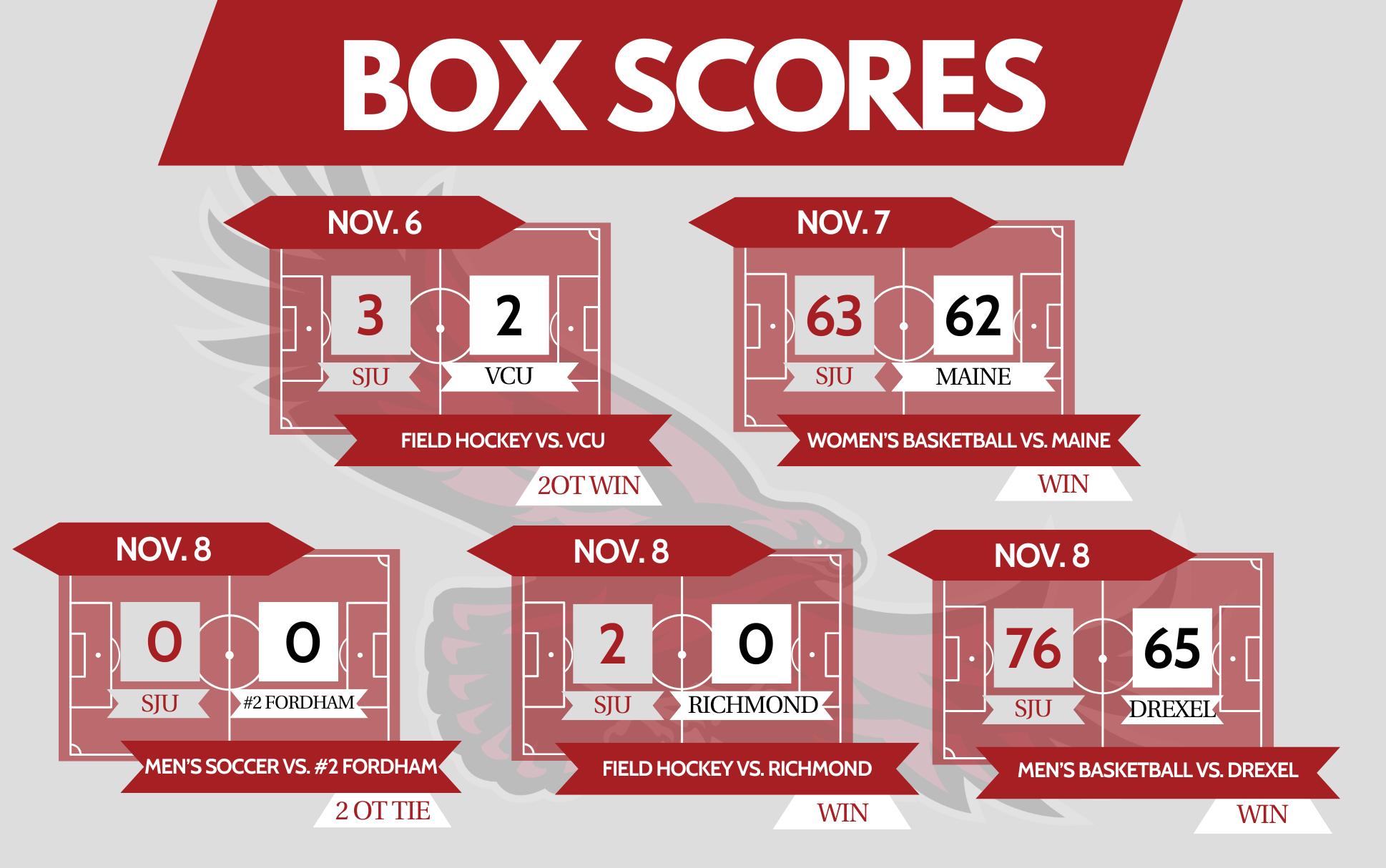
MONICA SOWINSKI ’26
Assistant Sports Editor
MARGIS ’26
Assistant Sports Editor
St. Joe’s field hockey blanked the top-seeded Richmond 2-0 to secure a fifth consecutive Atlantic 10 Championship Nov. 8. This rematch comes after a regular season loss to the Spiders Oct. 17.
Triple-threat junior back Milou Kluyt earned A-10 Defensive Player of the Year, Second Team All-Conference and All-Academic Honors Nov. 5. In her third A-10 Championship win, Kluyt earned Most Outstanding Player for the tournament.
“All our work we put in this season finally paid off,” Kluyt said. “We faced a lot of adversity this year, but we finally showed that we are able to beat this and beat teams.”
Starting the game off strong, Kluyt scored her fifth goal in three games to put the Hawks on the board in less than five minutes into the first quarter. The team ended the second quarter shutting out the Spiders. The Hawks defense allowed two
shots, with fifth-year goalkeeper Paige Kieft saving a goal to secure a shutout.
One of five Hawks to earn tournament honors, senior midfielder/back Emily Tammaro earned All-Championship honors for two assists and one goal in the Nov. 6 game against VCU and one assist in the Nov. 8 Hawks win. Tammaro said the team’s regular season loss to Richmond was motivation to prepare them for the A-10 rematch.
Hardships this season have allowed the Hawks to “lean on each other and just connect,” Tammaro said.
Head coach Hannah Prince feels “amazing” about the win, especially because players are unafraid to set their goals higher in order to achieve more than what they think they can.
“It’s a pride thing, it’s a relentless attitude thing, it’s a hard working thing, and I think that’s really helped propel us to even higher levels than we have,” Prince said.
The Hawks did not let a new roster this season get in the way of achieving the second-longest streak in A-10 history. After
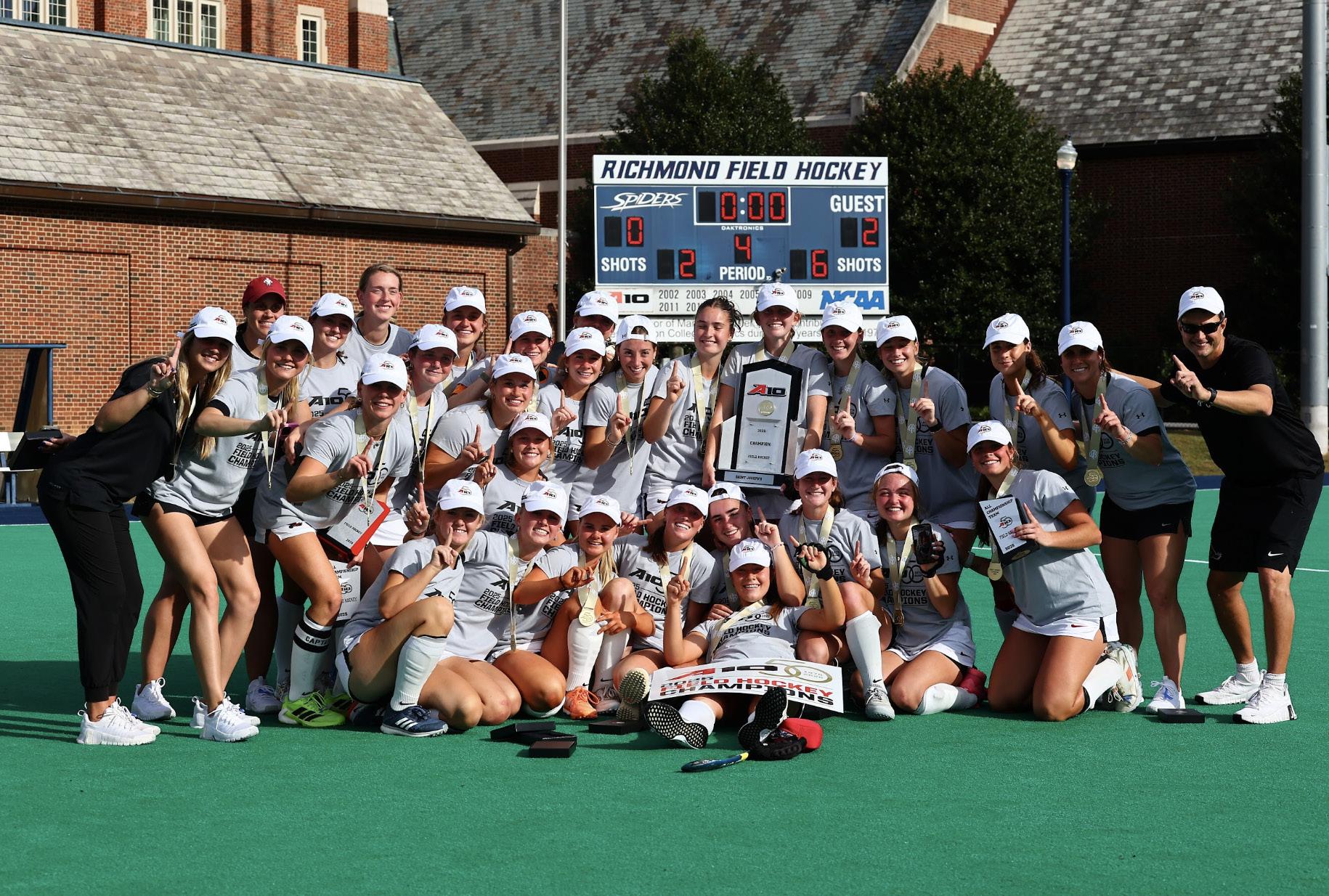

a season of training and spending time outside of practice to really get to know one another, Kluyt said the connection on the team is only “getting stronger.”
“We bonded so well, and it finally shows on the field now,” Kluyt said.
After five years of winning the A-10 Championship, there is still a difference this year, Prince said.
“They really instilled the mindset and the belief that you can win in any single moment in any single game,” Prince said. “That has been the biggest difference maker from my first year back in [2022] until now.”
Prince credits the newcomers for adapting and loving to “buy in” to the Hawk family culture. The veteran players who experienced the 2024 national championship run contributed to the winning culture of the team.
“They have a quiet confidence,” Prince said. “They always respect every opponent and always take every game and every practice seriously. It gives the rest of the group a lot of fuel and focus as we go forward.”
With 63 seconds left in the championship game, fifth-year forward/middle Ava Smith scored a goal to put the exclamation point on the Hawks win, which secured them an automatic bid to send St. Joe’s back to the NCAA Tournament.
With their NCAA tournament bid, the Hawks will be facing Drexel in the opening round, in Chapel Hill, North Carolina, Nov. 12. This marks a rematch for the team after falling to Drexel 3-2 in a shootout during the regular season.The winner will face the top-seeded North Carolina Nov. 14.
“I am super confident in our group that we can make some adjustments from the first time we played them to be able to propel us into that Sweet 16 round,” Prince said.
Kluyt said the Hawks are focused on going into the first round of the NCAA tournament with a “revenge attitude.”
“We know we’re able to beat them if we play like a team and if we just stay together,” Kluyt said.
SOWINSKI ’26
Assistant Sports Editor
The St. Joe’s men’s cross country team has showcased a sharp season with a first place finish at its first meet and two recent second place finishes at the Intercollegiate Association of Amateur Athletes Association Championship and Haverford Invitational Oct. 17 and Oct. 24, respectively.
The Hawks started off the season on the right track Aug. 29 with a first place finish at the Lehigh Invitational. Nine Hawks opened the season with accomplishing personal best times.
After a great season opener, the Hawks had a sharp showing at the Spiked Shoe Invitational Sept. 12, placing fourth. The positive turnout was a strong indicator of a great season ahead. Head coach Mike Glavin said the performance at the Spiked Shoe Invitational set the tone for the rest of the season.
“They ran so well in that,” Mike Glavin said. “They went like, ‘OK this is going to be one of these things everybody was invested in’ because they realized there could be something really good coming from it.”
Coming into the fall, most of the runners had trained together for multiple seasons at St. Joe’s or knew each other beforehand, coming from the Philadelphia and South Jersey areas. Because of this,
Mike Glavin knew this season was going to be “special.” Junior Michael Glavin said this advantage has allowed the team to be “developing well.”
Mike Glavin said the Hawks could feel the “blend” of the team coming together.
“The locker room was different this year than it has been over the past couple,” Mike Glavin said. “There was no doubt about that.”
When the Hawks earned second place at the IC4A Championship Oct. 17, they tied with the program’s best result since 2016. Two weeks later, the team finished second at the A-10 Championship Nov. 1 with Michael Glavin and junior transfer Gavin Mogck earning All-Conference and All-Conference First Teams honors, respectively.
Mogck said it was good to receive All-Conference honors at the A-10 Championship but that it was even better to finish second place with the team.
“Everybody on the team comes in and works hard every day,” Mogck said. “You see each other improve, and it’s good to see your hard work pay off.”
Both Michael Glavin and Mogck said a contributing factor to the team’s success this season is keeping their heads down and trusting the training.
“We all agree going into it ‘I think we can do this, so let’s go get after it,’’’ Michael

Glavin said. “But really just working at it — we’ve all put in the miles, so now you just get to enjoy it.”
Mogck added that the good energy the team carries from week to week is “the best fuel for going into races.”
Gearing up for the last
part
of
is “continuation” of the strong finishes throughout the season. The Hawks are ready to set higher goals at the NCAA Mid-Atlantic Regionals Nov. 14.